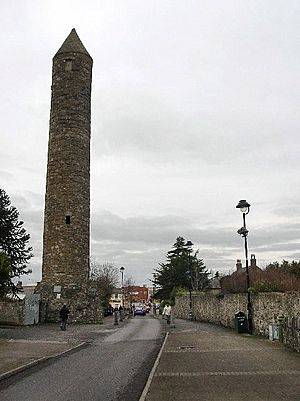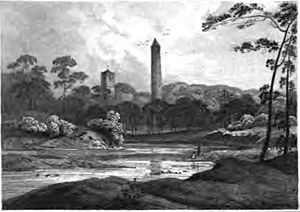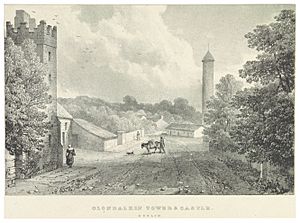Clondalkin facts for kids
Quick facts for kids
Clondalkin
Cluain Dolcáin
|
|
|---|---|
|
Suburban town
|
|

The Clondalkin round tower
|
|
| Country | Ireland |
| Province | Leinster |
| County | County Dublin |
| Local government area | South Dublin |
| Population
(2022)
|
|
| • Electoral division | 47,938 |
| Time zone | UTC+0 (WET) |
| • Summer (DST) | UTC-1 (IST (WEST)) |
| Eircode routing key |
D22
|
Clondalkin (which means "pasture of Dolcán" in Irish) is a town located in County Dublin, Ireland. It is about 10 kilometers (6 miles) west of Dublin city centre. The area is managed by South Dublin. A famous round tower from the 8th century is a key landmark here.
Clondalkin is also the name of a civil parish and a townland. A townland is a small area of land. The population of Clondalkin was 47,938 people in 2022.
Contents
Clondalkin's History
Ancient Times
People first settled in the Clondalkin area about 7,600 years ago. They chose this spot because it was good for living. It was near the River Camac and overlooked the River Liffey. This area also offered a good path between the mountains and the river. You can still find signs of early Celtic tribes, like old mounds and forts.
Early Christian Era
Clondalkin is thought to have been started by Saint Cronan Mochua. He created a monastic settlement, which is like a religious community, over 1,400 years ago. This was around the late 500s or early 600s. The famous round tower was built later, around 790 AD. It was part of the monastery. This tower is special because most round towers were built much later. By the 8th century, Saint Fugillus was a bishop in Clondalkin. Important religious books were made here, like the Clondalkin mass book.
Vikings and Normans
In 832 AD, Vikings attacked Clondalkin. They burned the monastery. Later, in the mid-800s, a Viking king named Amlaíb Conung built a fort here. In 867, a leader from Loígis burned the fort and killed many of Amlaíb's followers. The monastery was rebuilt later. It helped teach the Viking settlers about Christianity. The Vikings controlled the area until Brian Boru defeated them. This happened at the famous Battle of Clontarf in 1014.
Clondalkin saw another big event during the Norman invasion in 1171. A battle took place between Richard de Clare, also known as Strongbow, and Ruaidhrí Ua Conchabhair. Ruaidhrí was the last High King of Ireland.
Later History
Centuries later, Clondalkin was involved in the 1641 Rebellion. This was when Irish people rebelled against rule from England.
The Clondalkin Paper Mill started in the early 1800s. It made paper and was very busy during the First World War. The mill closed down in 1987. Water from Brittas ponds powered the mill.
| Historical population | ||
|---|---|---|
| Year | Pop. | ±% |
| 1821 | 597 | — |
| 1831 | 1,632 | +173.4% |
| 1841 | 505 | −69.1% |
| 1851 | 474 | −6.1% |
| 1861 | 668 | +40.9% |
| 1871 | 470 | −29.6% |
| 1881 | 379 | −19.4% |
| 1891 | 310 | −18.2% |
| 1901 | 276 | −11.0% |
| 1911 | 271 | −1.8% |
| 1926 | 345 | +27.3% |
| 1936 | 598 | +73.3% |
| 1946 | 1,042 | +74.2% |
| 1951 | 1,432 | +37.4% |
| 1956 | 3,105 | +116.8% |
| 1961 | 3,434 | +10.6% |
| 1966 | 5,079 | +47.9% |
| 1971 | 7,009 | +38.0% |
| 1981 | 23,444 | +234.5% |
| 1986 | 34,879 | +48.8% |
| 1991 | 38,489 | +10.4% |
| 1996 | 41,335 | +7.4% |
| 2002 | 42,729 | +3.4% |
| 2006 | 43,879 | +2.7% |
| 2011 | 45,165 | +2.9% |
Important Old Places
The round tower is a main landmark in Clondalkin. It is from the 8th century. It is one of only four towers left in historic County Dublin. This tower is considered one of the oldest in Ireland. It stands 25.6 meters (84 feet) tall. It still has its original pointed top.
In 2017, The Round Tower Heritage Centre opened. It cost €3.5 million to build. This center helps people learn about the tower and Clondalkin's history. It has interactive displays and a garden.
Clondalkin also has St Brigid's Well. People say Saint Brigid started this well in the 5th century. It was used to baptize people who were not Christian. Many believed the well had healing powers. Tully's Castle is another old castle here. It is a National Monument.
What You'll Find Here
Clondalkin had about 46,000 people living there in 2016. You can find many shops, including big supermarkets. The village center also has small businesses. These include restaurants, pubs, and pharmacies.
Clondalkin has a branch of South Dublin Libraries. One library building used to be a Carnegie Library. A new library, North Clondalkin Library, was set to open in late 2019. There is also a post office. St. John's Church was built in 1789.
Wheatfield Prison and Cloverhill Prison are two prisons located near Clondalkin. Many big companies have offices or data centers in Grange Castle Business Park. These include Microsoft, Google, and Amazon.
In 2014, Clondalkin became the 51st "Fairtrade town" in Ireland. This means the town supports fair prices for farmers.
Getting Around
Clondalkin has good public transport. You can take buses to Dublin city center and other nearby towns.
Dublin Bus offers many routes, like the 13, 60, and 68. Go-Ahead Ireland also has bus routes, such as the W2. These buses connect Clondalkin to places like Liffey Valley and Tallaght.
The Luas Red Line tram also serves the area. It runs from the Red Cow station to Tallaght and Dublin city center. The Luas station is about a 15-20 minute walk from Clondalkin village.
Clondalkin railway station opened in 1846. It was closed for goods in 1947. It reopened in the 1990s for people traveling to work. Iarnród Éireann (Irish Rail) runs trains from Heuston station to Kildare Town. A new station, Fonthill, was built to replace the old one.
Bus Éireann services stop at Newlands Cross near Clondalkin. These buses go to many places in the west and south of Ireland. There are plans for a Dublin Metro West line to include Clondalkin.
Local News and Media
Clondalkin has two local newspapers. They are the Clondalkin Echo and the Clondalkin Gazette. The Clondalkin News is also delivered free to homes in the area.
Sports and Clubs
GAA
The oldest sports club in town is the Round Towers GAA Club. It started in 1884. Club members have played for Dublin in big competitions. Jim Gavin won an All-Ireland senior medal in 1995. He also won many as a manager in the 2010s.
Soccer
Clondalkin Celtic F.C. is the town's main soccer team. It was formed in 1969. Other local teams include Booth Road Celtic and Knockmitten United. St Francis Boys FC plays at John Hyland Park.
Rugby
Rugby union is played at Clondalkin Rugby Club. The club started in 1973–74. It has many teams for different age groups.
Boxing
Bernard Dunne is from Clondalkin. He was a World Boxing Association (WBA) Super Bantamweight World Champion. Kenny Egan also comes from Clondalkin. He won a silver medal for boxing at the 2008 Olympics.
Basketball
Dublin Lions Basketball Club has many teams. They play in different leagues for men and ladies. They also have teams for children and a training academy. The club uses Coláiste Bride and Moyle Park College.
The main baseball field in Ireland is O'Malley Field. It is in Corkagh Demesne Park in Clondalkin. This is where the Irish national baseball team plays.
Schools and Learning
Clondalkin has many primary and secondary schools.
Primary schools include St. Ronans and Clonburris National School. Secondary schools are Moyle Park College (for boys) and Coláiste Bríde (for girls).
There are also three Gaelscoileanna (Irish-language schools). These include Gaelscoil Chluain Dolcáin and Coláiste Chilliain.
Community Groups
Clondalkin has many community groups. These include a Toastmasters International club and an Order of Malta branch. There are also youth groups like Clondalkin Youth Theatre.
St Joseph's Pipe band started in 1937. They have won many All-Ireland Championship Titles. The Clondalkin Youth Band started in 1986.
Scouting Ireland groups meet in the Scout Hall. Girl guides and Brownies meet at St John's Parish Hall. Local drama groups include Clondalkin Drama Group.
The Clondalkin Tidy Towns group started in 2012. They work to keep the town clean and beautiful. They have won awards for their efforts. The Civil Defence has a unit in Deansrath. They help with things like firefighting and medical services.
The Irish Language in Clondalkin
Áras Chrónáin helps promote the Irish language and culture. This includes Irish music and dancing. Muintir Chrónáin has won national awards for promoting Irish.
About 1,500 students in Clondalkin speak Irish. They attend the two Gaelscoileanna (Irish primary schools) and the Gaelcholáiste (Irish secondary school). There have been ideas to make Clondalkin an Irish Language Network region. This would be based on how many people speak Irish there.
Famous People from Clondalkin
- Karl Bermingham, footballer
- Mic Christopher, singer-songwriter
- Brendan Courtney, television presenter
- Seán Dillon, footballer
- Bernard Dunne, boxer
- Kenny Egan, boxer
- Jim Gavin, footballer and manager
- Mary Kennedy, television host
- Cathal Mac Coille, broadcaster and journalist
- Sinéad Mulvey, singer, represented Ireland in the 2009 Eurovision Song Contest
- Adrienne Murphy, model and Miss Universe Ireland 2012
- Derek Murray, footballer
- Graham Norton, comedian and presenter
- Neil O'Donoghue, American footballer
- Stephen Quinn, footballer
- Dermot Ryan, Archbishop of Dublin (1972–1984)
- Aidan Turner, actor
- Katharine Tynan, novelist
- Glenn Whelan, footballer
- Arthur Wolfe, 1st Viscount Kilwarden
- Simon Young, broadcaster
Clondalkin's Weather
Clondalkin has a mild climate. The temperatures do not change much between highs and lows. There is also enough rain throughout the year. This type of weather is called a "Marine West Coast Climate."
| Climate data for Clondalkin | |||||||||||||
|---|---|---|---|---|---|---|---|---|---|---|---|---|---|
| Month | Jan | Feb | Mar | Apr | May | Jun | Jul | Aug | Sep | Oct | Nov | Dec | Year |
| Mean daily maximum °C (°F) | 8 (46) |
8 (47) |
10 (50) |
12 (54) |
15 (59) |
18 (64) |
20 (68) |
19 (67) |
17 (63) |
13 (56) |
10 (50) |
8 (47) |
13 (56) |
| Mean daily minimum °C (°F) | 2 (36) |
2 (36) |
3 (38) |
4 (39) |
7 (44) |
9 (49) |
12 (53) |
11 (52) |
9 (49) |
7 (45) |
4 (40) |
2 (36) |
6 (43) |
| Average precipitation mm (inches) | 66 (2.6) |
51 (2) |
51 (2) |
48 (1.9) |
61 (2.4) |
53 (2.1) |
51 (2) |
64 (2.5) |
71 (2.8) |
71 (2.8) |
69 (2.7) |
79 (3.1) |
730 (28.9) |
| Source: Weatherbase | |||||||||||||
See also
 In Spanish: Clondalkin para niños
In Spanish: Clondalkin para niños




